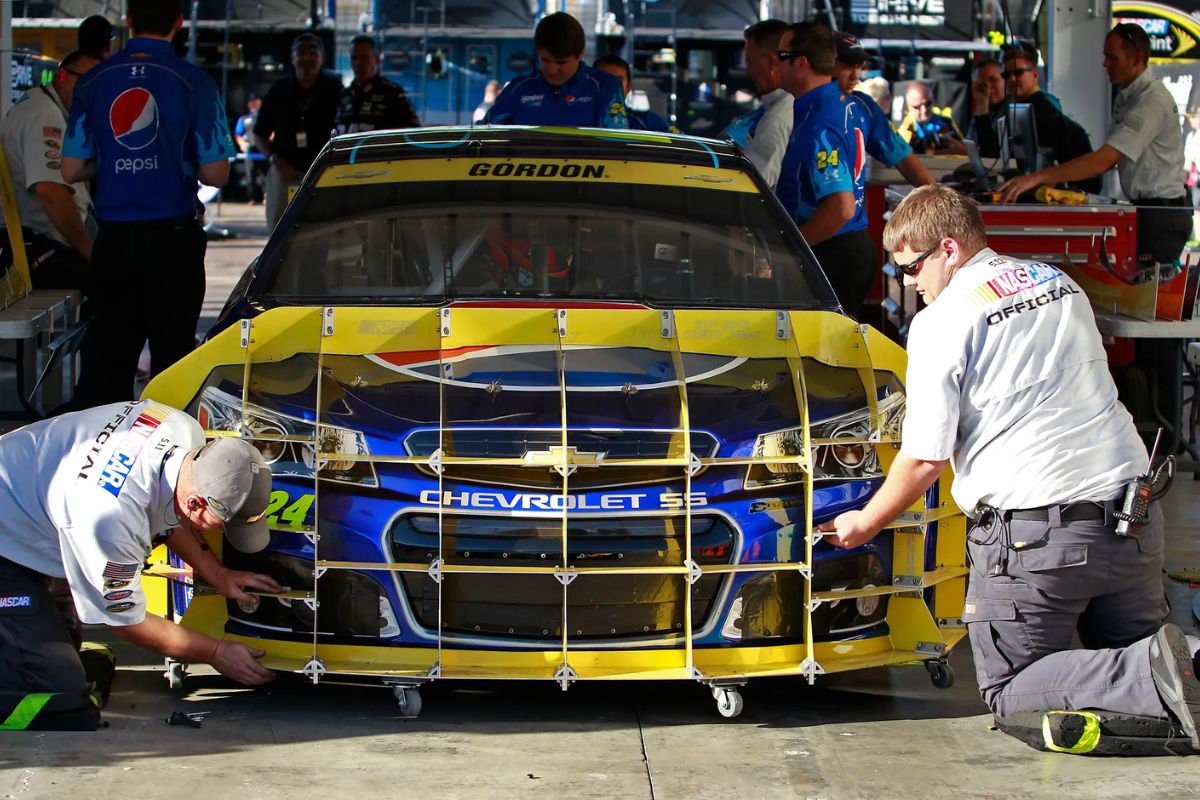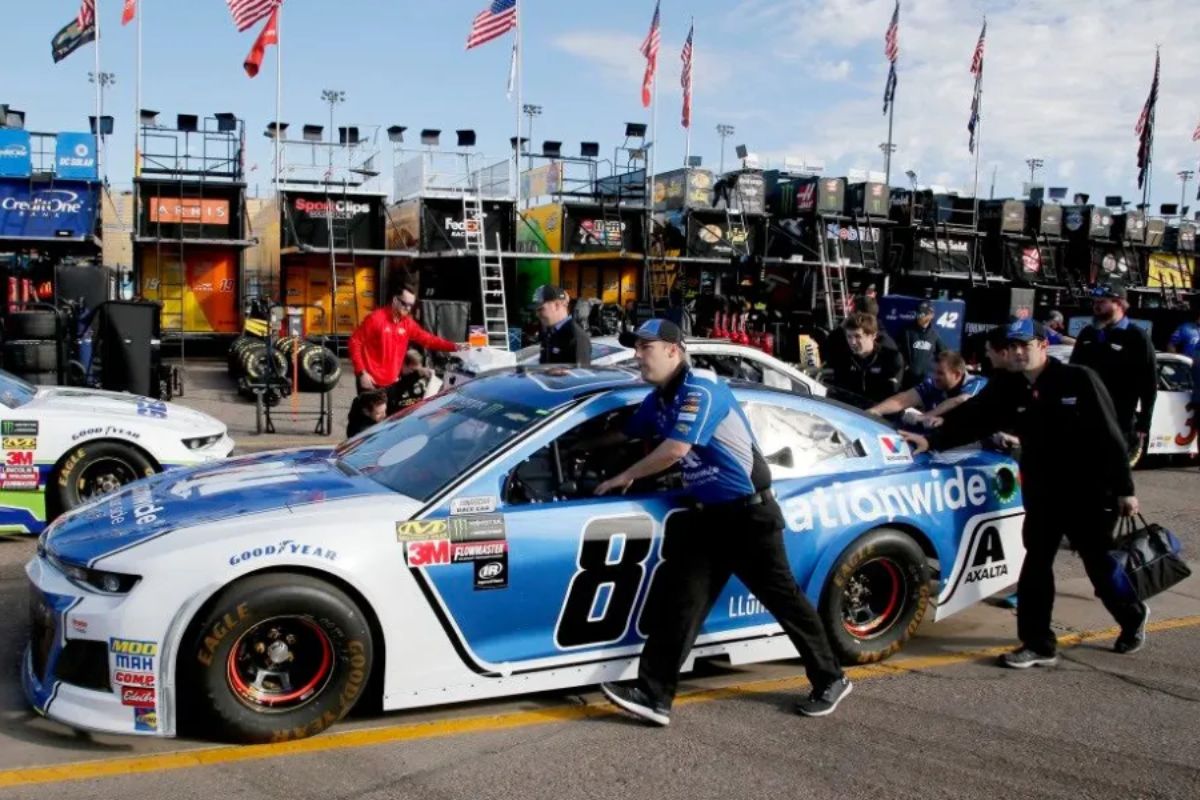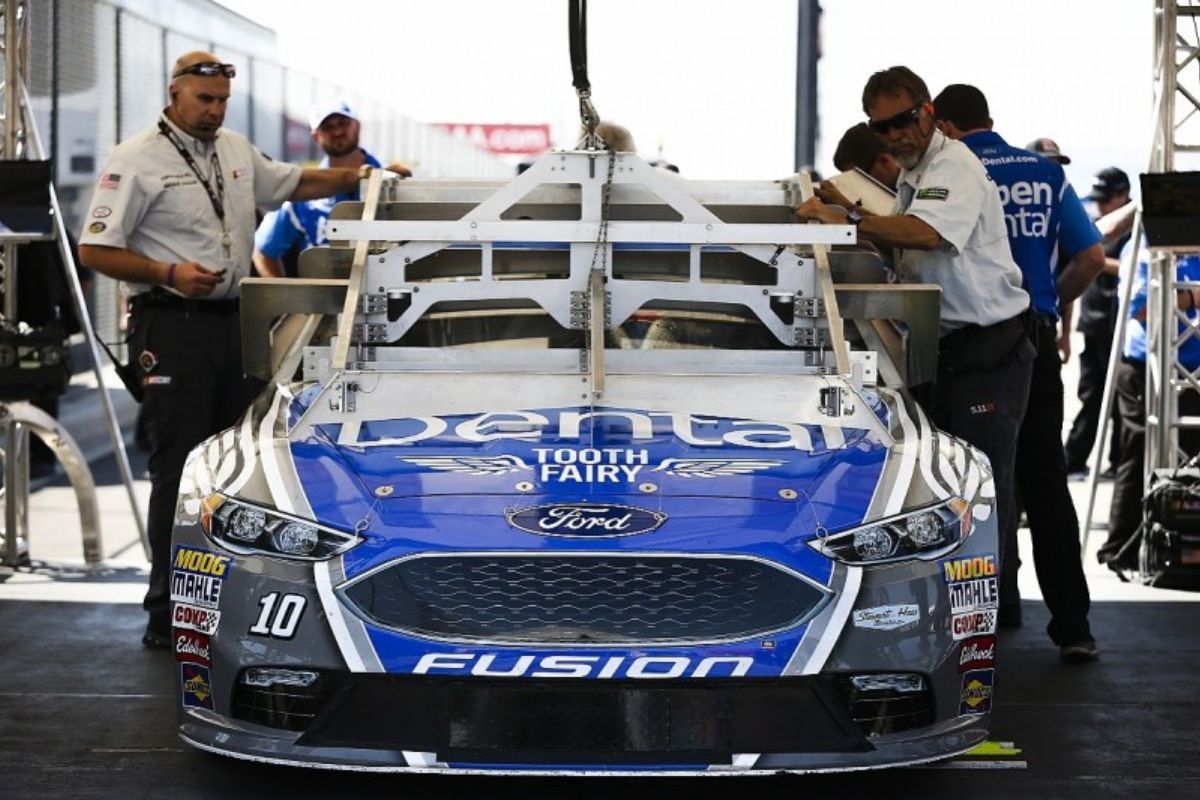NASCAR Tech Inspection: In NASCAR racing, the Tech Inspection stands as a critical bastion of fairness and competition integrity. With the introduction of the Optical Scanning Station (OSS), the precision of inspections has reached unprecedented levels, marrying technology with regulatory rigor to scrutinize every inch of competing vehicles. This evolution from manual checks to detailed digital mapping guarantees that all cars meet stringent standards, effectively minimizing gray areas that teams might exploit. However, as technology advances, so too do the strategies for circumventing the rules.
Key Takeaways
- NASCAR uses an Optical Scanning Station with cameras and projectors to ensure cars meet strict specifications.
- The inspection process checks alignment with virtual blueprints to a precision of 150,000 of an inch.
- Pre-scan preparations include treating reflective surfaces to avoid inaccuracies during the scanning process.
- Regulations enforce immediate adjustments for cars that fail to comply with the set tolerance margins.
- Strict inspections uphold race integrity by ensuring all teams start from an equal competitive standpoint.
Evolution of NASCAR Inspection Methods
The inspection methods in NASCAR have undergone significant transformation, evolving from simple template-based checks to sophisticated, technology-driven processes that guarantee car legality with greater precision and reliability.
Initially, NASCAR’s inspection protocols relied heavily on physical templates. Mechanics would manually align these templates with different parts of the racecar to confirm conformity with the standard dimensions and shapes dictated by NASCAR regulations. This method, while effective at the time, had limitations in regard to accuracy and consistency, giving rise to potential human error and discrepancies in the interpretation of the rules.
As technology advanced, NASCAR sought to improve the integrity of its competition by integrating more precise and less subjective tools into its inspection process. This shift included the adoption of laser measuring systems which provided a significant leap in the accuracy of car assessments. These systems use laser beams to create a detailed 3D map of the car, which is then compared against a digital model that represents the ideal NASCAR racecar. This comparison is far more precise than the traditional template method, reducing the possibility of discrepancies and ensuring that all cars meet the exact specifications required for competition.
Furthermore, this evolution reflects NASCAR’s commitment to fairness and competition. By reducing the human element in car inspections, NASCAR ensures a level playing field where technology, rather than interpretation, dictates legality.
Optical Scanning Station (OSS)
The implementation of the OSS has greatly transformed the precision and efficiency of NASCAR’s technical inspections. By employing 16 high-resolution cameras and eight sophisticated projectors, the OSS creates a detailed heat map of a racecar, enabling a highly precise assessment of its compliance with NASCAR’s stringent regulations.
This advanced system contrasts sharply with the prior method that relied on physical templates to gauge car legality. The OSS’s technology not only ensures a more thorough evaluation but also minimizes human error and variability that often came with manual inspections. The heat map produced by the OSS provides a visual representation, highlighting areas of the vehicle that may deviate from the regulated specifications. This allows inspectors to pinpoint specific aspects of the car’s geometry and surface that require adjustment, ensuring each vehicle meets the same standards of fairness and performance.
Transition to the Optical Scanning Station
NASCAR’s shift to the Optical Scanning Station in 2018 marked a significant advancement in the enforcement of car legality, eliminating the loopholes that previously allowed for creative interpretations of the rules by racing teams. This technology, also known as the hawk-eye, brought an innovative approach to vehicle inspections, moving from manual, template-based inspections to a digital, more precise system. The Optical Scanning Station uses high-resolution cameras and scanning technology to create a detailed 3D model of the race car, comparing it carefully against the digital model of a regulation-compliant vehicle.
The change to this technology was driven by the necessity to uphold a level playing field within the competitive environment of NASCAR. As teams became increasingly sophisticated in exploiting the flexibility of the old template system, the governing body recognized the need for a more robust and less ambiguous method. The Optical Scanning Station provided this by delivering detailed and accurate measurements of the car’s body and chassis, ensuring compliance with NASCAR’s stringent standards.
This shift not only improved the integrity and fairness of the competition but also streamlined the inspection process, reducing human error and the subjectivity associated with physical templates. The hawk-eye system scrutinizes every inch of the car, leaving zero room for the previously exploited gray areas.
Procedures before Scanning
Before commencing the Optical Scanning Station process, teams must carefully prepare the racecar, ensuring that windshields and wheels are adequately covered and certain reflective paint colors are treated with a non-reflective spray. This meticulous preparation is vital as the OSS employs an advanced system of 157,000 laser beams that scan the vehicle within 30 seconds, creating a detailed heat map. Reflective surfaces can distort this data, leading to inaccuracies in the scan results.
The necessity to cover the windshields and wheels is not merely a procedural formality but a critical requirement to prevent any reflections that might interfere with the laser beams. The OSS’s precision in detecting minute discrepancies in the car’s structure and surface is highly sensitive to any external reflective interference. Hence, ensuring that these parts are non-reflective is paramount.
Similarly, the treatment of certain paint colors with a non-reflective spray is a strategic step to nullify potential reflection issues. The choice of paint and its finish can have a significant impact on the outcome of the scanning process. Colors that naturally reflect more light can create ‘hot spots’ in the heat map, which might suggest modifications not actually present. This specific preparation ensures that the scan accurately represents the car’s physical attributes without the influence of color properties or glossiness.
Strictness of NASCAR’s Legality Test
Examining the importance of NASCAR’s legality tests reveals an exceptionally high standard, where even a discrepancy as minute as 150,000 of an inch from the pre-determined CAD model can deem a racecar illegal, as explained by JGR mechanic. This level of precision highlights a fundamental aspect of the sport—ensuring a level playing field where engineering excellence and strategic insight are what distinguish winners from the rest.
“It (OSS) scans the entire body surface of the car and then spits out an image that shows you how close you are to the CAD model of the body. It lets us be plus or minus a 150,000 of an inch in any section of the body. If we’re shallower than a 150,000 on any section or more proud of the CAD surface on any spot, we are deemed illegal. We have to fix that and then go through tech again.” – JGR mechanic.
The Optical Scanning Station (OSS), central to this rigorous inspection process, utilizes advanced scanning technology to carefully compare the actual racecar build to its virtual blueprint.
The OSS generates a detailed image that highlights variances between the car’s surface and the CAD model, allowing for a tolerance margin of just 150,000 of an inch. This minuscule tolerance can lead to significant repercussions. A team found to have a car that falls outside these stringent parameters must undertake immediate modifications to conform to regulatory standards, often under the demands of race day timelines.
News in Brief: NASCAR Tech Inspection
NASCAR’s adoption of the Optical Scanning Station represents a crucial advancement in race car inspection, ensuring strict adherence to regulatory standards. This technology enhances the accuracy of inspections, mitigating previous ambiguities and promoting fairness in competition.
The evolution from manual checks to precision-based scanning highlights NASCAR’s commitment to integrity and equitable racing conditions, focusing on engineering expertise and strategic intelligence rather than exploiting regulatory loopholes, thereby elevating the sport’s competitive spirit.
Our Reader’s Queries
Q. What is NASCAR post race inspection?
A. After the checkered flag waves, NASCAR’s job is far from over. Officials must now dive into post-race inspection. The spotlight is on the top five cars, undergoing meticulous scrutiny for any discrepancies. This crucial phase often uncovers significant infractions.
Q. How many HP is a NASCAR?
A. In the world of NASCAR Cup Series, the sheer horsepower output is awe-inspiring, clocking in at around 750 horsepower. This formidable power is the heartbeat of the series, fueling the adrenaline-pumping speed and thrill that define each race.
ALSO READ: Inside NASCAR Tech Inspection: Unveiling the Hidden Secrets!




